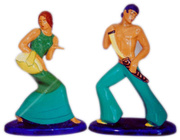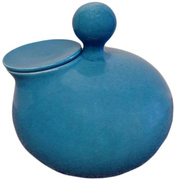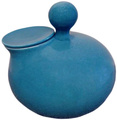For home-front America, World War II was a time of shared sacrifice, when people gave up simple pleasures to support those fighting overseas in the greatest struggle the civilized world had ever known. After the war, though, society breathed a collective sigh of relief and went out looking for a bit of fun.
One of the easiest things to do was to update one’s décor, as Donald-Brian Johnson discovered when he and co-author, Leslie Piña, began researching “Postwar Pop: Memorabilia of the Mid-20th Century,” which focuses on art pottery, paper goods, and holiday ephemera, and was published in 2011 by Schiffer. “During the war and immediately after it, foreign imports had been cut off, so all of these domestic art pottery firms sprang up,” Johnson says. “They were very successful until the early 1950s, when imports from Japan took over. By the time the ’60s rolled around, most of the U.S. firms were out of business.”

Above: Hedi Schoop’s “Blue Dancers” were sold as a pair. Top: Marie the Maid and Antoine the Chef wall pockets by The California Cleminsons.
Coincidentally, some of the most influential figures in what Johnson calls postwar pop pottery were named Betty. Between 1941 and 1955, Betty Harrington designed nearly 1,000 different objects for Ceramic Arts Studio of Madison, Wisconsin. Beginning in 1943, Betty Cleminson and her husband, George, sold their homey and heartwarming work as The California Cleminsons. And Betty Lou Nichols, considered by Johnson to be the queen of head vases, began her career in 1945 in the backyard of her parents’ La Habra, California, home.
“Joan Crawford loved Sascha Brastoff’s work and bought it regularly.”
One of the first artists of the era to break into the ceramics figurine world was Hedi Schoop, who moved to Los Angeles from Switzerland with her husband, composer Frederick Hollander, and opened her business in 1940. “Schoop had been an actress,” says Johnson, “and was kind of dabbling in making dolls out of wax. One day somebody said to her, ‘Those dolls are really spectacular. If you could find a more permanent form for them, there’d probably be a market.’ Schoop became one of the best-known ceramic designers of the ’40s and ’50s.”
Schoop’s slip-cast figurines were often clad in long, draping garments, their heads tilted to the left or the right to give them a coy expression. Many of her characters were taken from European sources—there’s a Tyrolean girl in yellow, a Dutch brother and sister in blue clogs—while others are clearly Western riffs on Asian sources—a pair of Siamese dancers wear blue pagoda-like hats on their heads, while the “Oriental” musicians on the front of an oval vase suggest the graphic approach used by artist Mary Blair for Disneyland’s “It’s a Small World” attraction.
The Cleminson’s work was folksier and more humorous than Schoop’s (see their “Morning After” mug above). “Betty Cleminson’s pieces were whimsical, but also useful,” says Johnson. “A lot of them had cute sayings on them that Betty wrote. She made string holders, pie birds, wall pockets, and other things you’d use around the house. Her razor-blade bank was a popular one, as was the girl with freckles that looked like a head vase. When I first saw it, I thought it was a mug, except it didn’t have a handle. Turns out you were supposed to put a dish scrubber in it.”
With ceramic figurines, the biggest sellers were usually the pairs. “People put them on end tables on either side of a couch, or on night tables at either side of a bed,” says Johnson. “There was just more of a market for pairs.”
Ceramic Arts Studio made the most of this trend by making its pairs as both regular figurines and salt-and-pepper shakers. That way, they could appeal to multiple audiences. “The unlikeliest figurines were sometimes made into salt-and-pepper shakers,” says Johnson. “One Betty Harrington design paired a ‘Fire Man’ and ‘Fire Woman’, each around 11 inches tall, that were artistic representations of what fire would look like if it assumed a human form. They had human faces, but their clothing and such were all rendered as flames. They’re wonderful figurines, but it’s difficult to imagine using them as salt-and-pepper shakers.”
And then there was Betty Lou Nichols. “Her work is important because it was so distinctive,” Johnson says. “You simply cannot see a Betty Lou Nichols piece and not know it’s hers. They have bright, red lips and those big eyelashes, which were hand-applied.”
With Nichols pieces, though, it’s hard to find one in pristine condition. “Her pieces had so many little add-ons, ruffles and things like that,” says Johnson. “Today, most of her head vases are missing part of an eyelash, or a piece of ruffle has been chipped. They just had so many places where they could be damaged. Betty Lou Nichols’s daughter still has quite a restoration business going.”
Competition from within the U.S. and abroad eventually sunk all the Bettys, as well as Schoop. Indeed, the arc of Schoop’s company was typical of many. “In the 1940s and ’50s, not only was Schoop imitated and undermined by imports, many of her former employees opened their own studios, too,” says Johnson. “More often than not, they used designs that were extremely similar to hers. They would add their own original touches but the overall styling was a lot like hers, so she had to spend a lot of her time trying to tamp down the competition that was infringing on her designs.”
Schoop’s most prominent competitor was former employee Katherine Schuefftan, known professionally as Kay McHugh. “After leaving Schoop, McHugh and her husband opened a studio; she signed her pieces ‘Kaye.’ Hedi Schoop actually sued McHugh in the early ’40s for copying her work, and the judge sided with Schoop. McHugh had to cease making such direct imitations, although she didn’t have to pay damages; her products soon resurfaced under a different name, ‘Kaye of Hollywood.’ Another prominent former Schoop employee, Yona Lippin, also released figurines that were definitely Hedi-influenced.”
But the real competition came from overseas. “When that happened,” Johnson says, “people could buy similar pieces at their local five-and-dime store for a fraction of the cost. Domestic firms run by designers like Schoop simply could not compete.”
Even industry giant Ceramic Arts Studio, which produced 500,000 figurines a year at the height of its production, was a target of plagiarists. “Some of the imitators would simply make a mold of a Ceramic Arts Studio figurine. The copies they produced had similarities, but they were imprecise. When Ceramic Arts Studio closed in 1955, co-founder Reuben Sand sold many of the copyrights and molds to one of the main firms that had been copying him without permission. Sand told me he might as well get some money out of it as long as he was going out of business.”
Other areas of the postwar art pottery world had their own mini-rivalries. “Sascha Brastoff was a Los Angeles designer who was really good at promoting himself,” says Johnson. “Designer Marc Bellaire worked with him. When Bellaire went out on his own, his work clearly showed some Brastoff style similarities, although it was a little more ‘out there’ in terms of shape and design. Bellaire’s designs seem somewhat more contemporary than Brastoff’s,” Johnson adds, “in the sense that his depictions are not quite as literal. Bellaire’s people don’t have all their features; their bodies have kind of an alien look to them.”

Betty Harrington designed almost 1,000 pieces for Ceramic Arts Studio, including “Salome.” Photo: John Petzold
Brastoff had a knack for attracting influential people. “He designed costumes in Hollywood, some for Carmen Miranda. He was in the service during World War II, back in the days when they did all-soldier shows. He would take part in those shows; along the way, Hollywood stars collected his pieces. Winthrop Rockefeller, the great philanthropist and investor, liked Brastoff’s work so much, he helped him open a studio in Los Angeles to show off his work.”
Howard Pierce’s abstraction was more minimalist. “He’d give you the idea of a horse or a gazelle, their most prominent elements, and from there you’d identify what the figurine was. He also did a number of cameo vases, kind of like Wedgwood, but they weren’t very popular for him. They were almost too traditional. The best examples of his work are the simplest pieces, like a horse whose mane appears blown back, like he’s standing in the wind. Pierce could say a lot with minimal lines and just a few types of glazes.”

“Mary Lou” is a classic Betty Lou Nichols head vase, with thick eyelashes and lots of breakable edges.
For those with very traditional tastes, there was Roselane. “People felt comfortable with Roselane,” says Johnson. “The pieces weren’t quite as scary as some of Bellaire’s, which didn’t fit with every décor. Roselane’s work was soothing, lots of horses and deer. Except for those ‘sparkler’ pieces with the rhinestone eyes, which were just kind of horrible.”
Today when we look at postwar pottery, be it Roselane or Schoop, we see something people collect. Back in their day, though, these pieces were everyday design accents, like the stuff you might find as you head to the checkout at IKEA. “Today people collect these pieces based on a particular style, or maybe even an artist,” says Johnson. “When most of these things were created, there might have been a few people on the cutting edge who were stocking up on Marc Bellaire or Sascha Brastoff because they really liked the artists. For example, Joan Crawford loved Sascha Brastoff’s work and bought it regularly. However, it was usually more of a stylistic choice for the buyer. Most people in the 1950s were simply buying these things as décor items to brighten up their homes.”
That changed in the 1980s when collectors of both art pottery and kitsch started paying attention to head vases from the 1940s and ’50s. “I’ve done a lot of research on head vases,” says Johnson, “but I haven’t run across any reference to who might have come up with the concept first. Florists loved them because they’d have all these little blossoms that weren’t big enough for large arrangements. But they could take a small arrangement of flowers and sell them in an inexpensive head vase.”
To contemporary head vase collectors, the quality of Betty Harrington’s work for Ceramic Arts Studio and pieces made by Betty Lou Nichols make those objects especially desirable. “There was such attention to detail,” says Johnson, “and the glazes are also really good. In a lot of figural ceramics from the ’50s, the skin of the figure is all cracked because the glazes haven’t held up. Pieces made by Ceramic Arts Studio and Betty Lou Nichols haven’t been prone to crazing, so the pieces you see today look like they did when they were originally released.”

By the 1950s, head vases such as this one designed by Kathi Urbach, were being imported from Japan by companies like Ucagco.
Other collectors only acquire certain types of head vases, like ones that have bouffant hair, or a female figure with one hand held up by the side of her face. “There are all these subtle delineations of the head vase,” says Johnson. “I’ve been to some head vase collectors’ homes, and it can be a little daunting because every place you go there are shelves filled with eyes looking at you.
“One collector even had them in her bathroom around the tub,” Johnson continues. “Her husband built shelves there for her collection, but when their granddaughter came over, she always had to turn the vases toward wall. The little girl didn’t like having all those heads looking at her.”
(All visuals from “Postwar Pop: Memorabilia of the Mid-20th Century,” by Donald-Brian Johnson and Leslie Piña, copyright 2011, Schiffer Publishing, Ltd., used with permission. All photos are by Piña and Johnson, except as indicated. If you buy something through a link in this article, Collectors Weekly may get a share of the sale. Learn more.)








 American Art Pottery
American Art Pottery
 Cowan Art Pottery of the Art Deco Era
Cowan Art Pottery of the Art Deco Era American Art Pottery
American Art Pottery Red Wing Beyond the Crock: Larry Roschen on the Stoneware Legend’s Dinnerware
Red Wing Beyond the Crock: Larry Roschen on the Stoneware Legend’s Dinnerware Head VasesThe terms “head vase,” “lady head vase,” or “head planters” refer to a styl…
Head VasesThe terms “head vase,” “lady head vase,” or “head planters” refer to a styl… ChalkwareMade out of plaster of Paris, chalkware was used to create inexpensive vers…
ChalkwareMade out of plaster of Paris, chalkware was used to create inexpensive vers… Mid-Century PotteryThere are two sides—at the very least—to Mid-Century Modern pottery. Over h…
Mid-Century PotteryThere are two sides—at the very least—to Mid-Century Modern pottery. Over h… Holt-Howard CollectiblesIn 1949, three college friends launched the Holt-Howard Company with a fami…
Holt-Howard CollectiblesIn 1949, three college friends launched the Holt-Howard Company with a fami… FigurinesIn “Miller’s Collecting Porcelain,” you can almost hear the renowned porcel…
FigurinesIn “Miller’s Collecting Porcelain,” you can almost hear the renowned porcel… Mari Tepper: Laying it on the Line
Mari Tepper: Laying it on the Line Nice Ice: Valerie Hammond on the Genteel Charm of Vintage Canadian Costume Jewelry
Nice Ice: Valerie Hammond on the Genteel Charm of Vintage Canadian Costume Jewelry How Jim Heimann Got Crazy for California Architecture
How Jim Heimann Got Crazy for California Architecture Modernist Man: Jock Peters May Be the Most Influential Architect You've Never Heard Of
Modernist Man: Jock Peters May Be the Most Influential Architect You've Never Heard Of Meet Cute: Were Kokeshi Dolls the Models for Hello Kitty, Pokemon, and Be@rbrick?
Meet Cute: Were Kokeshi Dolls the Models for Hello Kitty, Pokemon, and Be@rbrick? When the King of Comedy Posters Set His Surreal Sights on the World of Rock 'n' Roll
When the King of Comedy Posters Set His Surreal Sights on the World of Rock 'n' Roll How One Artist Makes New Art From Old Coloring Books and Found Photos
How One Artist Makes New Art From Old Coloring Books and Found Photos Say Cheese! How Bad Photography Has Changed Our Definition of Good Pictures
Say Cheese! How Bad Photography Has Changed Our Definition of Good Pictures Middle Earthenware: One Family's Quest to Reclaim Its Place in British Pottery History
Middle Earthenware: One Family's Quest to Reclaim Its Place in British Pottery History Fancy Fowl: How an Evil Sea Captain and a Beloved Queen Made the World Crave KFC
Fancy Fowl: How an Evil Sea Captain and a Beloved Queen Made the World Crave KFC
Great article, Ben!
very very nice and great posting!!!
I enjoyed yor article. I have collected Cleminson Pottery for some time and would appreciate any additional articles, resources, info that you might be willing to share.
I am researching work by Kathi Urbach, and found this essay interesting. She was my godmother.
Excellent article, learned a bunch. Thank you!
Nicely done . I enjoyed reading this Ben .
The younger generations wont use bar soap cause its icky, they certainly dont wanna DUST all these tchotchkis….
BUT at the same time, they have replace this stuff with Funko Pop and Star Wars figurines!